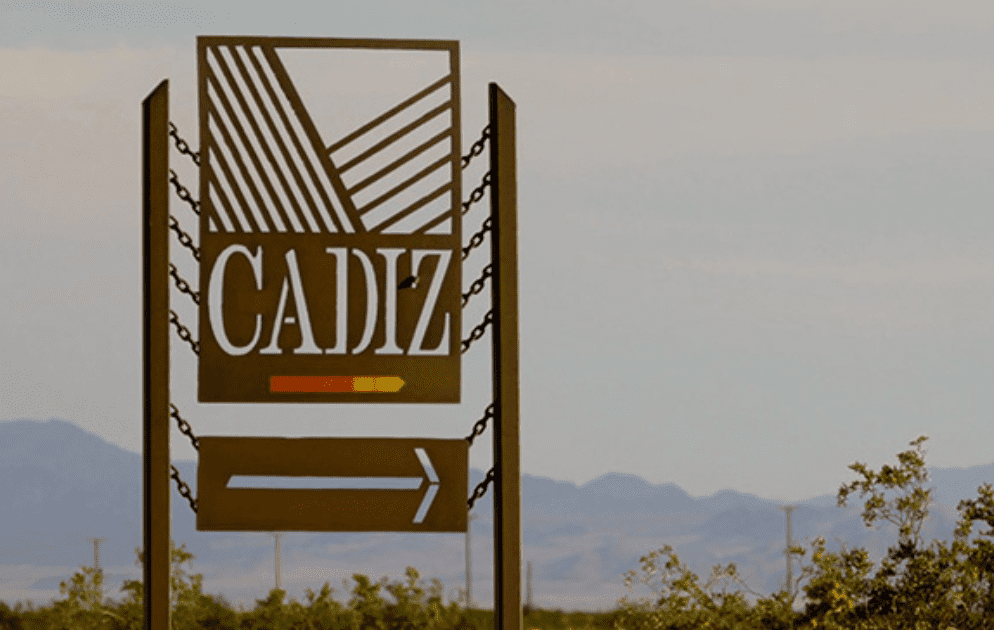Opinion: What is Cadiz, and why does it matter?

By Pamela Casey Nagler
The story of Cadiz begins in the 1980s, when British investor Keith Brackpool arrived in California after pleading guilty to criminal charges relating to securities trading in Britain.
In 1983, Brackpool teamed up with others to locate water sources for development and sale to municipalities. Studying satellite images, he located an aquifer in the Mojave, and proceeded to buy up a patchwork of creosote scrub for the private corporation he founded: Cadiz, Inc. He remains connected to Cadiz today. He was appointed to the board in 1986, served as CEO from 1991 to 2013, and as board chair from 2001 to 2022.
In the 1990s, Brackpool hatched a plan to store trillions of gallons of Colorado River water beneath the Cadiz tract and to extract water from its underlying aquifer. He began courting the Metropolitan Water District of Southern California, the agency which serves 26 Southland public water agencies, including Claremont’s Three Valleys Municipal Water District. Although MWD seriously considered the partnership, in 2002, it bailed.
In 2009, Los Angeles Times columnist Michael Hiltzik acknowledged the scheme had “a sort of shimmering authenticity, like a desert mirage.” But while Cadiz promoted the project as an answer to our water shortage, the Colorado River simply has no surplus to store.
However, Cadiz continued to propose new plans and seek new partners.
Also in 2009, Cadiz proposed supplying water to Southern California neighborhoods, pumped from their Cadiz aquifer “before it evaporates,” via a pipeline. In 2012, Orange County’s Santa Margarita Water District approved Cadiz’ environmental documents. The San Bernardino County Board of Supervisors followed suit.
Thus began TVMWD’s involvement with Cadiz. That year, Three Valleys voted to “reserve supply and storage from the [Cadiz] project in the event it is constructed,” wrote TVMWD board member Brian Bowcock in his October 7, 2022 COURIER Readers’ Comment.
In the meantime, Cadiz faced several lawsuits from various environmental groups.
In 2015, the LA Times’ Bettina Boxall wrote, “Cadiz has acknowledged that over the long term, the project will extract more groundwater than is replenished by nature.”
Federal scientists expressed concern that the operation could dry up springs vital to wildlife on the nearby Mojave National Preserve and other public lands. Experts disagree over exactly how much groundwater there is underlying the Cadiz tract, how much the company could legally pump out, and how pumping could affect neighboring aquifers with the contamination of carcinogenic minerals.
In Boxall’s 2015 story, United States Senator Dianne Feinstein voiced her opposition, declaring it folly to draw down the aquifer. “I remain concerned the Cadiz project could damage the Mojave Desert beyond repair … We need to use water more responsibly, not less, and the Cadiz project is a bad idea.”
Appointees of the Trump administration were determined to waive environmental concerns and fast-track projects like Cadiz, and approved its pipeline permit.
In June 2019, the TVMWD Board approved a study of the Cadiz Water Project’s impact on nearby Bonanza Spring, the largest fresh water spring system in the Mojave.
While an environmental review sounds appropriate, the Cadiz study has not met the standards of a peer-reviewed analysis. Led by Anthony Brown of Aquilogic, Inc., a longtime advocate for Cadiz, the study has all the earmarks of an “in-house” promotion.
Just last month, on September 13, a federal court threw out Cadiz’ pipeline permit, stating it was approved without tribal consultation or review of the environmental impacts on nearby national parks, monuments and sacred sites. Representatives from various organizations, including the Native American Land Conservancy, National Parks Conservation Association’s California Desert Program, Mojave National Preserve Conservancy and Sierra Club, among others, have lauded this decision.
A week later, the TVMWD Board emerged from a closed session and announced it had voted to terminate its role in the Cadiz study. While this sounds like something to celebrate, board member Bowcock reminded us that walking away from the Cadiz study may expose TVMWD to legal action. “They’re going to sue us. And rightfully so,” he said.
Thus far it appears Cadiz hasn’t produced the study, or paid the more than $1 million it promised to TVWMD. Differing amounts have been mentioned, but it’s very difficult for the public to determine what has or hasn’t been paid. Bowcock told the COURIER “We never did see it … We never received $805,000.”
Cadiz’ official response to September’s federal court ruling is “it will have no impact” on the completion of what they now call the “Cadiz Water Conservation and Storage Project.”
Stay tuned.
Pamela Casey Nagler is a Claremont resident.









0 Comments